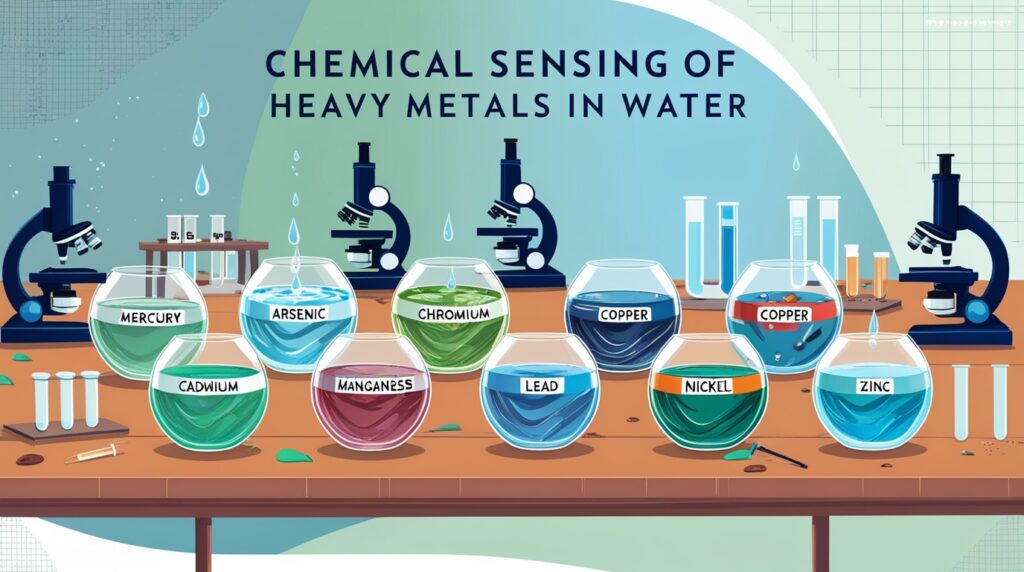
Introduction
Chemical sensing of heavy metals in water refers to the methods and technologies used to detect and quantify toxic heavy metals in water sources, crucial for safeguarding public health and environmental integrity. Heavy metals, such as mercury, arsenic, cadmium, and lead, can contaminate drinking water through industrial discharges, mining activities, and infrastructure degradation. Their presence poses significant health risks, even at low concentrations, and is linked to serious illnesses, including cancer and neurological disorders.
The detection of heavy metals in water is notable due to the increasing global focus on water quality and safety, driven by stringent regulations such as the European Drinking Water Directive (DWD). As these standards evolve, advanced chemical sensing techniques have emerged to meet the demand for rapid, accurate, and cost-effective detection methods. Various technologies, including electrochemical sensors, microfluidic devices, and optical detection methods, are employed to improve sensitivity and specificity in identifying contaminants.
Despite advancements, challenges remain in the chemical sensing of heavy metals, including interference from other ions in water samples and the need for reliable calibration across various sensing platforms. Additionally, regulatory pressures and the necessity for portable detection systems highlight the ongoing research efforts aimed at developing innovative solutions to ensure safe drinking water and protect public health. These developments are essential not only for compliance with regulatory standards but also for real-time monitoring of water quality in diverse settings.
Types of Heavy Metals
Heavy metals are a group of dense metals that can pose serious health risks at low concentrations. Although there is no universally accepted definition, these elements generally share certain characteristics: they have a high density (ranging from 3.5 to 7 g/cm), are poisonous at low levels, and exhibit metallic properties. Various heavy metals can contaminate drinking water from sources such as mining operations, industrial activities, and leaching from household plumbing systems.
Common Heavy Metals in Drinking Water
Mercury
Mercury exists in the environment in three primary forms: elemental mercury, inorganic mercury, and methyl-mercury. Elemental mercury, commonly known as quicksilver, is found in thermometers and certain dental products. Inorganic mercury is often released into the environment from manufacturing and coal-fired power plants, while methyl-mercury is a highly toxic organic form that accumulates in fish and can be ingested by humans through contaminated water or food.
Symptoms of mercury toxicity include nausea, muscle weakness, and impaired coordination, with severe cases potentially leading to death.
Arsenic
Arsenic is a known carcinogen often found in areas with volcanic activity. It is commonly used in rat poisons and industrial applications. Chronic exposure to arsenic is particularly dangerous, as it may result in symptoms like a garlicky breath, metallic taste, and various nervous system disorders. The maximum contaminant level (MCL) for arsenic in drinking water is set at 0.1 mg/L (10 ppb).
Chromium
Chromium appears in two forms: trivalent chromium (chromium-3) and hexavalent chromium (chromium-6). The latter, often associated with industrial pollution, has garnered attention for its potential health effects. While trivalent chromium is an essential nutrient, hexavalent chromium is less understood in terms of its human toxicity, though it has been linked to high blood pressure and dermatitis. The MCL for chromium is 0.1 mg/L (100 ppb).
Copper
Copper, a metal used extensively in plumbing, can leach into drinking water, primarily from pipes and fixtures. While typically present in lower concentrations, long-term exposure can lead to health issues, including gastrointestinal problems and liver damage. The environmental sources of copper include mining and metal processing industries.
Cadmium
Cadmium is a naturally occurring metal that can contaminate water supplies through erosion or improper industrial waste disposal. Long-term exposure to cadmium can result in kidney damage and weakened bones, while acute exposure may cause vomiting and diarrhea. Cadmium is primarily found in regions with heavy metal processing activities and is a concern for public health due to its cumulative effects.
Manganese
Manganese is a trace mineral essential for human health, but excessive levels can cause neurological issues. It can enter water supplies through industrial runoff or natural mineral deposits. Monitoring manganese levels in drinking water is crucial to prevent potential health risks associated with its overconsumption.
Chemical Sensing Techniques
Chemical sensing techniques for heavy metal detection in water have evolved significantly, utilizing a variety of methods and materials to enhance sensitivity and specificity. This section outlines some of the prominent techniques employed in this field, including electrochemical methods, microfluidic sensors, optical detection, and advanced materials.
Electrochemical Methods
Electrochemical sensors are pivotal for the detection of heavy metals due to their high sensitivity and rapid response time. Bismuth-based electrodes, for instance, have been identified as effective for detecting Cd²⁺ and Pb²⁺ due to their minimal toxicity and reduced sensitivity to dissolved oxygen (DO). Modified nanoporous bismuth electrodes (NPBiEs) have been developed to facilitate this detection, showing promise in real-time applications.
Additionally, printed electrochemical sensors, such as screen-printed electrodes (SPEs), are increasingly popular due to their cost-effectiveness and user-friendliness, allowing for mass production and single-use capabilities.
Microfluidic Sensors
Microfluidic sensors represent a cutting-edge approach for heavy metal detection, leveraging the manipulation of fluids in microscale channels. These sensors offer advantages such as controlled liquid flow, minimal reagent usage, and rapid analysis, making them suitable for point-of-care applications.
Microfluidic devices can integrate various sensing modalities, including electrochemical and optical detection, to improve overall performance. For example, wearable bio-sensors have been developed using laser-engraved techniques to detect low levels of tyrosine and uric acid, while also enabling dynamic sweat sampling.
Optical Detection Techniques
Optical detection methods, such as colorimetry, fluorescence detection, and surface plasmon resonance (SPR), are widely employed for their specificity and ability to operate in dilute conditions. In colorimetry, the chemical reaction between heavy metals and specific reagents produces observable color changes that can be quantified.
SPR, a quantum optical-electrical phenomenon, offers label-free sensing capabilities by measuring the resonance angle changes as analytes interact with metal surfaces. The incorporation of metallic nanoparticles, such as gold (AuNPs) and silver (AgNPs), enhances the sensitivity of these optical techniques due to their unique plasmonic properties.
Advanced Materials
The use of advanced materials, particularly two-dimensional (2D) materials like transition metal dichalcogenides (TMDs), has revolutionized the development of chemical sensors. For example, MoS₂ transistors have been utilized in wearable sensors due to their high surface area and excellent charge transfer properties. The integration of these materials into sensing platforms allows for improved sensitivity and biocompatibility, crucial for applications in wearable technology and continuous monitoring systems.
Materials Used in Chemical Sensors
Chemical sensors for detecting heavy metals in water employ a variety of materials, each chosen for its unique properties and advantages in sensing applications.
Nanomaterials
Nanomaterials, particularly carbon-based nanostructures, play a significant role in the development of chemical sensors. Carbon nanotubes (CNTs), graphene, and fullerenes are among the most widely utilized carbon-based materials due to their high electrical conductivity, stability, and ease of surface modification.
Graphene, in particular, has garnered attention for its excellent sensitivity to electronic disruptions when interacting with target species, making it a prime candidate for environmental monitoring and point-of-care applications. Its unique structure, characterized by a high surface area and the availability of active sites, enhances its performance in sensor technologies.
Bismuth-Based Materials
Bismuth is regarded as an effective material for heavy metal sensors due to its minimal toxicity and partial insensitivity to dissolved oxygen. Researchers have developed modified nanoporous bismuth electrodes for the detection of metals such as cadmium (Cd²⁺) and lead (Pb²⁺), showcasing its potential in electrochemical sensing applications.
Polymer-Based Materials
Polymers, including those used in the fabrication of microfluidic devices, are also common in chemical sensors. Polydimethylsiloxane (PDMS) is frequently utilized due to its elasticity and cost-effectiveness, although it has limitations such as incompatibility with certain solvents. In contrast, thermoplastics like polystyrene (PS) and polyethylene terephthalate (PET) offer better solvent compatibility but face challenges with surface adhesion.
Printing Technologies
Innovations in printing technologies have facilitated the creation of low-cost, single-use sensors. Methods such as inkjet printing, 3D printing, and screen printing are extensively employed to produce electrodes that are user-friendly and economically viable for widespread applications. Screen-printed electrodes (SPEs) are particularly advantageous for their mass production and ease of use, making them suitable for field testing and disposable applications.
Signal Enhancers
Nanomaterials can also serve as signal enhancers in chemical sensors. Gold and platinum nanoparticles are commonly used as electrode materials, although they can exhibit limitations such as fouling when in contact with analytes. In contrast, carbon nanomaterials demonstrate greater stability and a wider potential window, reducing the issues associated with metal nanoparticles.
Applications
In Situ Water Quality Monitoring
The application of chemical sensing for heavy metals (HMs) in water is critical for in situ monitoring, particularly at source points of human consumption. This necessity has been amplified by the implementation of stringent European directives that require lower permissible contaminant levels.
The development of electrochemical sensors represents a promising avenue for meeting these requirements due to their portability, cost-effectiveness, and ability to perform multi-elemental detection in real-time. These sensors allow for quick analysis and on-line monitoring of water samples, thereby providing dynamic data essential for biogeochemical surveys and pollution alert systems.
Regulatory Compliance
European regulations such as the Water Framework Directive (WFD) and the Drinking Water Directive (DWD) set forth water quality standards that must be adhered to in order to safeguard public health and the environment. Since their inception, these directives have evolved to include various chemical parameters that must be monitored, including heavy metals. The recent renewal of the DWD aims to update and control 48 different parameters, highlighting the growing importance of reliable water quality monitoring systems capable of detecting contaminants in compliance with these regulations.
Portable Detection Technologies
The demand for portable, cost-effective heavy metal detection technologies has led to significant research and development efforts. Current commercial kits, although sensitive, often require complex image analysis or specific reagents that make them impractical for large-scale applications. In contrast, electrochemical methods have emerged as a superior option due to their simple sample preparation, low cost, and the ability to conduct analyses with minimal reagent usage. These advantages facilitate the development of user-friendly systems that are amenable to real-time environmental monitoring.
Automated Monitoring Systems
Advancements in automation have further enhanced the applicability of heavy metal sensors in water quality monitoring. For example, automated systems for continuous monitoring of cadmium have been developed, allowing for real-time assessments of both total and bioavailable cadmium levels. Such systems integrate various measurement cells and processes, enabling efficient data collection over extended periods. These automated devices significantly improve the ability to track heavy metal concentrations and facilitate timely responses to potential contamination events.
Integration with Wireless Technologies
The integration of wireless sensor networks (WSNs) and Internet of Things (IoT) technologies with heavy metal sensing devices is revolutionizing water quality monitoring. These systems can provide real-time data transmission and remote monitoring capabilities, making them suitable for both urban and rural applications. Enhanced communication capabilities enable rapid dissemination of water quality information, thereby improving public health and safety measures.
Challenges and Limitations [Chemical Sensing of Heavy Metals In Water]
The detection of heavy metals in water presents numerous challenges and limitations, primarily stemming from the need for high sensitivity and selectivity in sensor technologies. One significant hurdle is the interference caused by the presence of other ions in the sample matrix. For instance, the simultaneous detection of multiple heavy metals often leads to quantification difficulties, as observed with Cu2+ ions, which can interfere with the detection of Zn, Cd, and Pb using certain analytical devices.
This issue necessitates the development of more sophisticated sensors capable of distinguishing target analytes from potential interferents. Another challenge lies in the calibration and performance consistency of electrochemical sensors. Non-linear calibration curves have been noted, particularly for Hg2+ ions, due to complex interactions in the electrolyte solution, such as the formation of Hg2Cl2.
Furthermore, while methods like anodic stripping voltammetry exhibit high sensitivity, they often require extensive calibration and may not maintain performance over prolonged usage. Moreover, the choice of materials for sensor fabrication significantly impacts both sensitivity and cost. Many sensors capable of detecting heavy metals at low limits of detection (LODs) utilize expensive or delicate materials, limiting their practicality for widespread use in field applications.
The transition to more affordable alternatives without compromising performance remains an ongoing area of research. Lastly, regulatory pressures, such as the updated European Drinking Water Directive, mandate stricter limits for heavy metals, creating an urgent need for in situ monitoring solutions. The challenge is to develop portable and cost-effective detection techniques that comply with these new standards while also providing rapid and accurate results. The quest for innovative sensing technologies that can effectively meet these requirements is critical for ensuring safe drinking water and protecting public health.



